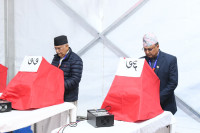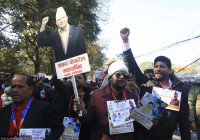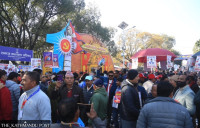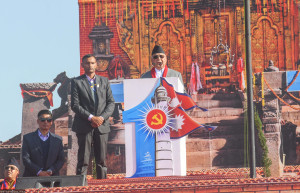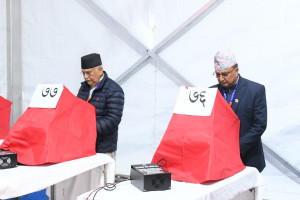Politics
Forget 2022: Parties hope to do well in 2027
Janamat Party is buoyed by its performance in the last polls while two other old regional forces are too enmeshed in power politics to focus on the next elections, analysts say.
Nishan Khatiwada
Nepal’s political parties have already begun their preparations for the next general and local polls. The ascendant Rastriya Swatantra Party has launched its ‘Mission Chaurasi’ campaign, with its eyes trained on the 2084 BS general election; the main opposition CPN-UML conducted its own two-month-long ‘Mission Grassroots’ in February; and the ruling Nepali Congress and CPN (Maoist Centre) have their own ‘transformation’ and ‘invigoration’ campaigns, respectively. With these campaigns, the political outfits aim to expand party organisation to the grassroots, strengthen their voter base and improve their electoral prospects.
The major Madhesh-based parties also have their eyes set on the elections, although they have been rather late to spring into action. The new CK Raut-led Janamat Party, which has been ambitiously building and expanding its organisation with the 2027 polls in mind, is an exception. The traditional Janata Samajbadi Party and Loktantrik Samajbadi Party appear to be clearly behind the curve. They are too enmeshed in power politics to focus on organisation building at the grassroots, observers say.
Janamat’s central member BP Sah claimed his party was the first among all Nepali parties to start an election-targeted campaign. “We have already conducted programmes at the ward and province levels and also begun to survey for candidates,” he said. “Our goal is to multiply our support base by five times until the next elections.” The party on Saturday conducted votes to determine the ‘approval rating’ of the local representatives elected from the party last year.
The Janamat Party, led by the once-secessionist leader Raut, took traditional parties by surprise in the 2022 parliamentary elections, the first it contested. The party won six seats and became a national party by getting over three percent of total proportional representation votes.
In one of the biggest upsets in the polls, Raut trounced the Janata Samajbadi chief Upendra Yadav by a huge margin of 18,063 votes in Saptari-2. Buoyed by its performance, the party launched its organisation building campaign right after the last polls, leaders say.
Sah said that the party is also giving its sister wings a full shape. It has also been trying to expand its organisation in hill areas.
By contrast, the Janata Samajbadi Party and the Loktantrik Samajbadi Party are yet to launch election-focused campaigns.
Janata Samajbadi Party central office chief Prakash Adhikari said the party will bring election-centric organisation building and strengthening campaigns based on the party statute. “The statute endorsed by the statute convention has been sent to the Election Commission. After we get it back, we will launch programmes targeting the next elections,” Adhikari said.
Meanwhile, the Loktantrik Samajbadi Party has been alarmed by its lacklustre electoral performance and by failure to become a national party, said leader Surendra Jha, adding it will soon launch organisations building programmes. “Despite having influential leaders at the ward level, we failed to mobilise the support base [in the last polls],” Jha said.
According to Jha, the party has in the pipeline programmes and ideas to strengthen the organisation to improve its electoral prospects and become a decisive force in both national and provincial politics. “We will introduce the campaigns within a month,” he said.
The Madhesh-based parties also have a cadre-base in the Tarai region of Koshi and Lumbini provinces. But the LSP has been struggling to effectively strengthen its organisations there. Even in Madhesh, their old stronghold, big political parties Congress and UML outperformed them in the last elections.
The Janata Samajbadi alone had 39 lawmakers in the 2017 Madhesh Provincial Assembly while the Loktantrik Samajbadi had 16. The current Madhesh provincial assembly has 18 members from Janata Samajbadi Party, 13 from Janamat Party, and nine from Loktantrik Samajbadi Party.
The strength of the traditional Madhesh-based parties is on the wane in national politics as well.
Currently, the Janata Samajbadi Party has 12 seats in the federal Parliament while the Loktantrik Samajbadi Party has 5. They had almost swept away the traditional parties in Madhesh in 2008, by winning 87 seats combined.
In the 2013 Constituent Assembly elections, Madhesh-based parties were limited to 12 federal seats. Then, in 2017, major Madhesh-based parties, Sanghiya Samajbadi Forum and the Rastriya Janata Party, jointly contested elections to win 34 seats in total.
Observers say the established Madhesh-based parties are enmeshed in politicking for power and are sidelining organisation-building activities.
Noting that the Janamat has been aggressive in organisation building and expansion, Chandra Kishore, a close analyst of Madheshi politics, said that while the JSP has become power-centric, the LSP has lost its organisation strength. “The JSP thinks it can retain its organisations and voter base by sticking to its power,” Chandra Kishore said. “On the other hand, as LSP chair Mahantha Thakur is close to the end of his political career, the party has been struggling to revive its weak organisations.”
Both the Janata Samajbadi and Loktantrik Samajbadi have joined provincial and central governments. Janamat Party, on the other hand, has joined the Madhesh government, and Prime Minister Dahal is preparing to induct a minister from Janamat Party in his Cabinet. The Maoist chief on Sunday recalled his party’s minister Aman Lal Modi from the position to create a space for a minister from the Janamat Party.
The Janata Samajbadi is in charge of two ministries and one ministry of state, while the Loktantrik Samajbadi has one ministry in the federal government. The former has also got important portfolios like the Vice President and the chief minister of Madhesh.
The Janata Samajbadi and the Loktantrik Samjabadi seem to be satisfied with power-sharing and have hence been passive, argues Rajanikant Jha, a Madhesh observer, echoing Chandra Kishore.
“The JSP has been failing to address intra-party dissatisfaction, prompted by the power-sharing. Many leaders were denied power and positions,” Jha said. “The two parties have nothing to protest against as they themselves are in the government. Their activities are almost non-existent in Tarai.”
As the traditional Madhesh-based forces fail to strengthen their organisations and expand support base, other parties have been trying to make inroads into their strongholds, say observers. In the 107-strong Madhesh provincial assembly, the Nepali Congress has 22 seats, UML 23 and the Maoist Centre eight seats.
“The UML has been trying to penetrate core Madhesh areas while the RSP has been focusing on urban areas and settlements near the Mahendra Highway,” Chandra Kishore said.
Jha, another analyst, added, “If the traditional Madhesh-based forces do not mend their ways soon, they will further shrink by the time of next elections.”




 7.12°C Kathmandu
7.12°C Kathmandu
